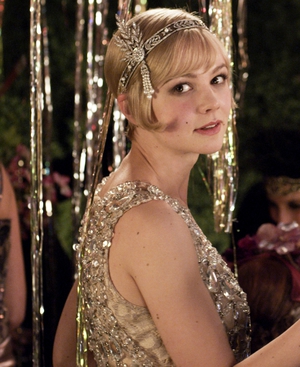
1920-1929: Another decade of change in American clothing
Origins
The picture above is an example of the hair and clothing style that became popular in the 1920's. The women who had the hairstyle and the type of clothes that the woman in the picture above does, are known as flappers. Flappers are young women who, after the war decided to speak out against the current beliefs (back then) about the role of women in society. Before the flappers came into existence, men (and older women) believed that women belonged in the kitchen or around the house cooking, cleaning, making babies and then taking care of them. But after WWI many of the young women decided to change the role of women in society. And so with that decision a new type of fashion emerged. No longer were the dresses long enough to touch the ground like in the previous decade. Now the skirts were shorter (not drastically shorter mind you) but just short enough to show the ankles. The hairstyle also changed to match the dress. Before the 1920's women had long hair, but during the 1920's many young girls cut their hair short. The flappers were seen as rebels by the men and older women of the American society. But the flappers didn't care, they started to smoke and drink like the men. (Many older people on society saw this behavior as disgraceful).
Primary Source: Many women celebrated the age of the flapper as a female declaration of independence. Experimentation with new looks, jobs, and lifestyles seemed liberating compared with the socially silenced woman in the Victorian Age. The flappers chose activities to please themselves, not a father or husband. But critics were quick to elucidate the shortcomings of flapperism. The political agenda embraced by the previous generation was largely ignored until the feminist revival of the 1960s. Many wondered if flappers were expressing themselves or acting like men. Smoking, drinking, and sexual experimentation were characteristic of the modern young woman. Short hair and bound chests added to the effect. One thing was certain: Despite the potential political and social gains or losses, the flappers of the 1920s sure managed to have a good time.
Purpose
This style mainly affected the youth of the 1920's in a positive way as it allowed for change in the way women behaved in society. Many men and older women opposed the flapper style. I believe that they viewed the style as inappropriate conduct for young ladies, especially since they were so carefree with their actions in public.
Value
The flapper style was purely the expression of young women who didn't want to wait for a guy to "sweep them off their feet" since so many of them already died in WWI. They wanted to live wild while they were young and actually enjoy the life they were living. They lived as if there was a chance that their youth would be taken away suddenly and they'd end up like the older generation of women.
Limitations
What the flapper style can't tell us about the 1920's is what was happening besides the rebellion of the youth of America. The Flapper style was normal in the day to day lives of young women so it wasn't unusual to see a young woman in a short dress and short hair walking down the street. Of course it was unusual at first but as more and more young women adopted this style it quickly became popular and not so out of the ordinary. What the flapper style can't tell us about the 1920's is the rise against prohibition or the crash of the stock market and the begining of the Great Depression in the late 1920's.


No comments:
Post a Comment